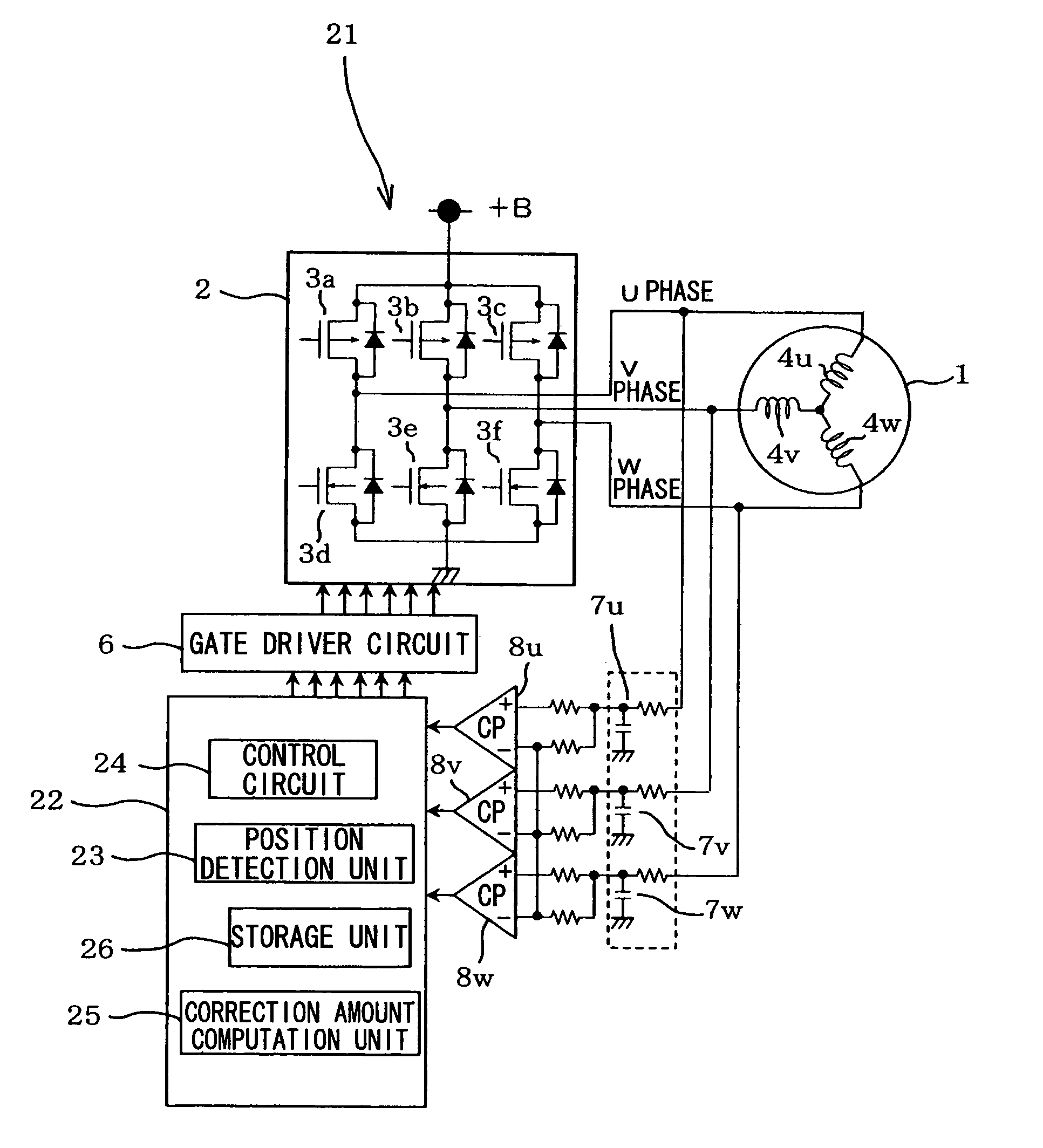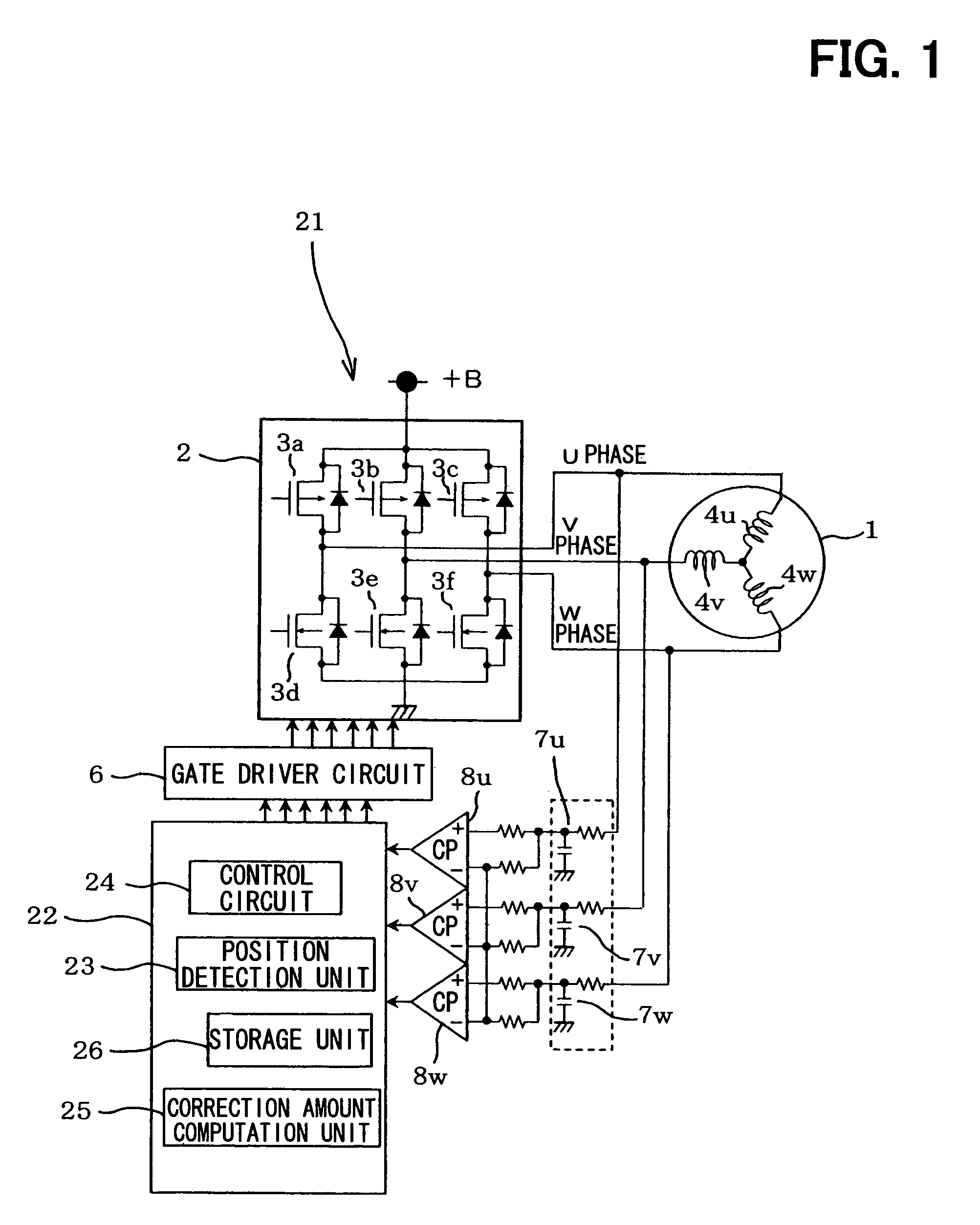Energization timing determination circuit and determination method for energization timing of motor
a technology of energization timing and determination circuit, which is applied in the direction of motor/generator/converter stopper, electronic commutator, dynamo-electric converter control, etc., can solve the problems of delay in the phase of the induced voltage signal, considerable variation, and inability to use hall elements in applications involving high-temperature environments, so as to reduce processing requirements and reduce processing load
- Summary
- Abstract
- Description
- Claims
- Application Information
AI Technical Summary
Benefits of technology
Problems solved by technology
Method used
Image
Examples
first embodiment
[0040]Hereafter, description will be given to a first embodiment of the invention with reference to the drawings from FIG. 1 to FIG. 4. The same members as in FIG. 10 will be marked with the same reference numerals, and the description of them will be omitted. Hereafter, description will be given to a difference. The configuration of a motor driving device 21 in this embodiment is such that the control unit 5 of the driving device 11 in FIG. 10 is replaced with a control unit 22. The control unit 22, which can operate as an energization timing determination circuit, includes a position detection unit 23, which can function as a position detecting means, a control circuit 24, which can function as a correcting means, a correction amount computation unit 25, which can function as a detected shift length computing means, and a storage unit 26 in place of a position detection unit 9 and a control circuit 10.
[0041]The correction amount computation unit 25 is a functional portion used to ...
second embodiment
[0060]FIG. 5 illustrates a second embodiment of the invention. The description of elements in common with the first embodiment that are marked with the same reference numerals is omitted for simplicity. Hereafter, description will be focused on the differences between the first and second embodiments. The construction of the second embodiment is basically the same as that of the first embodiment, except the details of processing carried out by the control unit 22. In the first embodiment, the motor 1 is assumed to be running at a constant speed, while in the second embodiments correction is carried out with the motor 1 assumed to be accelerated or decelerated.
[0061]The processing of S3 at which the latest Tx is stored in the flow illustrated in FIG. 3 is replaced with the processing in which the latest Tx is stored and at the same time, the original Tx, that is, Tx one cycle before is stored as Tx′ at S3′. At S6 in the first embodiment, it is determined whether data sufficient to co...
third embodiment
[0065]FIG. 6 illustrates a third embodiment of the invention. Description will be focused on the differences from the first embodiment. The series of processing shown in FIG. 6 is described as follows. When an affirmative determination that the switching signals equivalent to one cycle of electrical angle have been acquired, corresponding to YES at S6, TAVE is determined at S33 and TAVE0 is set to TAVE at S32. The control circuit 24 further determines the duty shift length α and the phase shift length β at S7′ and S8′ and stores the values αU, αV, αW, βU, βV, and βW in the storage unit 26, which can function as a storing means, at S31. Thereafter, processing proceeds to S9′. In the first embodiment, only the latest duty shift length α and phase shift length β, such as any of U, V, and W, to be corrected are determined. In the third embodiment, instead, αU, αV, αW, βU, βV, and βW are computed at a time and stored at S31. Since the correction value is in proportion to the cycle of ele...
PUM
 Login to View More
Login to View More Abstract
Description
Claims
Application Information
 Login to View More
Login to View More - R&D
- Intellectual Property
- Life Sciences
- Materials
- Tech Scout
- Unparalleled Data Quality
- Higher Quality Content
- 60% Fewer Hallucinations
Browse by: Latest US Patents, China's latest patents, Technical Efficacy Thesaurus, Application Domain, Technology Topic, Popular Technical Reports.
© 2025 PatSnap. All rights reserved.Legal|Privacy policy|Modern Slavery Act Transparency Statement|Sitemap|About US| Contact US: help@patsnap.com



